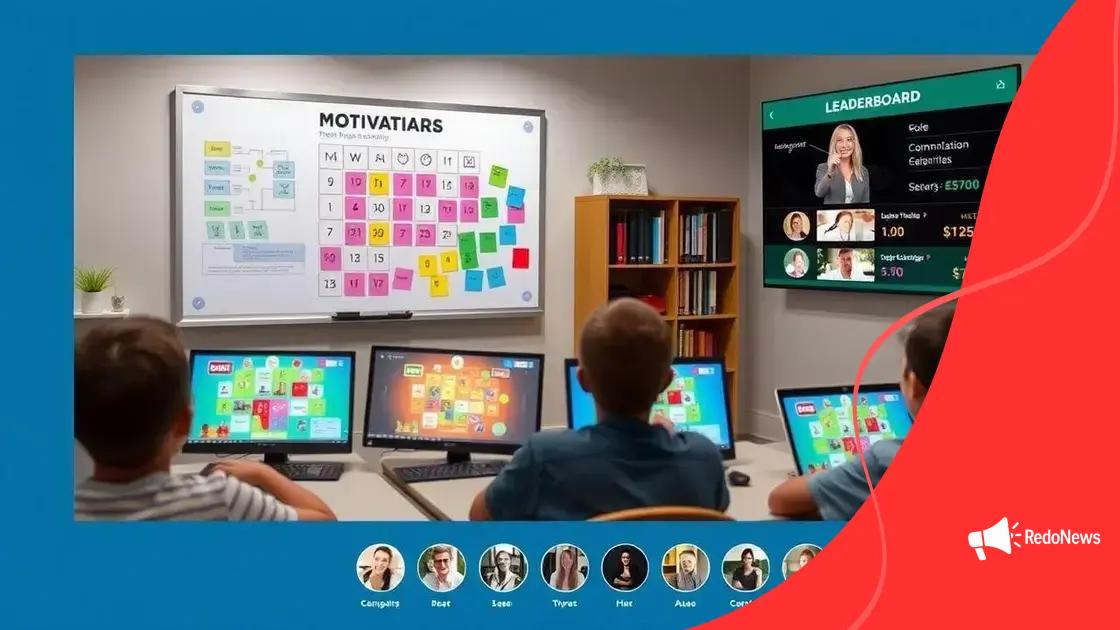Online learning: Engagement studied for better results

Online learning engagement is crucial for student success, achieved through interactive tools, personalized feedback, and a supportive environment, as seen in successful institutions like Khan Academy and the University of Phoenix.
Online learning: Engagement studied offers a fascinating glimpse into how students interact in digital classrooms. Have you ever wondered what keeps students motivated when lessons are online? Let’s explore the dynamics of engagement in virtual education.
Understanding the concept of online learning engagement
Understanding the concept of online learning engagement is essential for both educators and students. It refers to how students interact with the course material, instructors, and peers in a virtual environment. When students are engaged, they learn more effectively and retain information better.
Key Components of Engagement
There are several key components that contribute to online learning engagement. They include motivation, interaction, and feedback. These elements are vital for creating an engaging learning experience. Let’s delve into each one.
- Motivation: This can be intrinsic or extrinsic. Engaging content and relevant assignments encourage students to participate actively.
- Interaction: Opportunities for students to interact with peers and instructors foster a sense of community. This helps combat feelings of isolation often associated with online learning.
- Feedback: Timely feedback on assignments or discussions allows students to understand their progress. Feedback can motivate students to improve and stay involved in their learning journey.
Another crucial aspect of online learning engagement is the use of technology. Tools like discussion boards, video conferencing, and collaborative projects enhance interactions. They make learning more dynamic and enjoyable for students.
A well-designed course incorporates these elements. By offering engaging content and varied interactions, students are likely to feel more connected. This connection can lead to better performance and satisfaction in their learning experience. As educators, understanding how to create these environments can significantly impact student success.
Factors influencing engagement in virtual classes
Factors influencing engagement in virtual classes play a crucial role in determining how much students participate and learn. Understanding these factors can help educators create more effective online learning experiences. Key elements such as course design, student mindset, and instructor presence significantly impact engagement levels.
Course Design
Well-structured courses foster higher engagement. This includes clear learning objectives, engaging materials, and interactive assignments. Each component must work together to motivate students. When students feel the coursework is relevant and organized, they are more likely to engage.
- Clear Expectations: Providing clear guidelines ensures students know what is required, helping them stay on track.
- Interactive Content: Videos, quizzes, and group discussions keep students interested and involved in their learning.
- Assessments: Regular assessments give students feedback on their progress, encouraging continuous improvement.
The student mindset is another significant factor. Students who possess a growth mindset are more likely to embrace challenges and actively participate in virtual classes. When they see obstacles as opportunities for learning, their engagement rises.
Additionally, the presence of instructors can greatly influence student engagement. Instructors who are interactive and responsive create a welcoming environment. They can make use of tools like discussion forums and live Q&A sessions to enhance engagement. Students are more likely to participate when they feel supported by their instructors.
Another aspect is the social environment. Building a community among students can facilitate connections. Collaborative projects and group discussions can help students feel less isolated, promoting engagement.
Effective strategies to enhance student motivation

Effective strategies to enhance student motivation are vital for improving engagement in online learning environments. When students feel motivated, they are more likely to participate actively and succeed in their studies. Here are some strategies that can make a significant difference in online classes.
Incorporate Gamification
Gamification makes learning fun and engaging. By adding game-like elements to courses, such as points, badges, and leaderboards, students feel a sense of achievement. This approach not only boosts motivation but also encourages friendly competition.
- Points and Rewards: Give points for completing tasks to motivate students to engage.
- Badges: Recognize accomplishments with badges that students can showcase.
- Leaderboards: Highlight top performers to inspire others to strive for excellence.
Another way to enhance motivation is to provide relevant and meaningful content. Students are more likely to engage when they see how the material connects to their interests or future careers. Incorporating real-world applications of the concepts being taught can significantly increase motivation.
Additionally, offering choices in assignments can also boost motivation. When students have a say in their learning, they feel more invested. Choices can be as simple as selecting topics for projects or deciding how they want to demonstrate their understanding.
Create a Supportive Learning Environment
A supportive learning environment is crucial for motivating students. Encouraging open communication between instructors and students builds trust. When students feel comfortable asking questions or sharing their thoughts, they are more likely to engage deeply with the material.
- Regular Feedback: Provide timely and constructive feedback to help students improve.
- Encourage Peer Interaction: Foster a sense of community among students through group activities.
- Be Approachable: Make sure students know that they can reach out for help whenever they need it.
Lastly, recognizing student achievements is essential. Celebrating milestones, whether big or small, can enhance their motivation. This recognition can come in many forms, from shout-outs in class to certificates of accomplishment.
The role of technology in online learning engagement
The role of technology in online learning engagement is significant. Technology enables students to connect, collaborate, and access a wealth of information. By using various digital tools, instructors can create an interactive learning environment that holds students’ attention.
Interactive Tools
Interactive tools are essential in boosting engagement. Platforms like Zoom or Google Meet allow teachers and students to hold live classes. These tools facilitate real-time discussions, making learning more dynamic. Additionally, using virtual whiteboards enables collaborative brainstorming, which encourages participation.
- Discussion Forums: These provide a space for students to share ideas and ask questions outside of live classes.
- Polling Tools: Polls during lessons can gauge understanding and keep students involved.
- Quizzes and Games: Incorporating games helps reinforce learning in a fun way.
Furthermore, learning management systems (LMS) like Canvas or Moodle centralize resources. Students can access lectures, assignments, and additional reading materials in one place. This structure encourages them to engage more with the coursework. When everything is organized, students are less likely to feel overwhelmed.
Technology also enhances feedback mechanisms. Instructors can use tools to provide instant feedback on assignments. This helps students understand where they stand and what they need to improve. Additionally, personalized learning paths allow for a tailored experience that keeps students engaged at their level.
Using Multimedia Resources
Incorporating multimedia resources is another way technology plays a vital role in engagement. Videos, podcasts, and infographics make learning more appealing. For instance, a short video can explain complex concepts in a straightforward manner. This variety caters to different learning styles, aiding comprehension and retention.
- Videos: Visual and auditory learners benefit greatly from instructional videos.
- Podcasts: Students can listen to lectures on the go, making learning flexible.
- Infographics: Visual representations of information help simplify complex ideas.
Ultimately, technology bridges the gap between traditional learning and modern educational needs. It is indispensable in creating an engaging and effective online learning experience.
Real-world examples of successful online engagement
Real-world examples of successful online engagement show how various strategies have made a positive impact on learning outcomes. Different institutions and educators have implemented unique approaches that have proven effective in capturing students’ attention and fostering participation.
Example 1: Virtual Classrooms at University of Phoenix
The University of Phoenix has made strides in online learning engagement by using a blend of live lectures and engaging online discussions. They encourage students to participate in real-time sessions, allowing them to share insights and ask questions immediately. This interactive approach keeps students active and invested.
- Live Discussion Boards: Integrating live discussion boards during lectures allows students to share their thoughts instantly.
- Peer Interaction: Group activities help build a sense of community among students.
- Expert Guest Speakers: Inviting industry experts for Q&A sessions expands learning opportunities.
Students at the University of Phoenix report feeling more connected and motivated, leading to higher retention rates and satisfaction levels.
Example 2: Khan Academy’s Interactive Learning
Khan Academy is another exemplary case. This nonprofit offers free online courses that are rich in interactivity. Their platform enables students to learn at their own pace, with immediate feedback on quizzes and exercises. This characteristic increases engagement significantly.
- Personalized Learning Dashboard: Students can track their progress and set goals.
- Interactive Videos: Videos include embedded questions that prompt students to think critically.
- Game-like Elements: Users earn badges and points for completed tasks, making learning fun.
As a result, Khan Academy has successfully motivated learners around the globe, demonstrating how technology can enhance educational engagement.
Example 3: Google Classroom with Collaborative Projects
Google Classroom facilitates engagement through collaborative projects. Teachers create assignments that require teamwork, allowing students to contribute their ideas and skills. This collaboration fosters communication and engagement among peers.
- Group Projects: Students work together on projects using tools like Google Docs.
- Instant Feedback: Teachers provide quick feedback right on the assignment.
- Integration with Other Tools: Incorporating tools like YouTube and Forms enriches learning experiences.
These examples highlight the diverse ways online engagement can be successfully achieved. By prioritizing interactive and collaborative elements, educators can create vibrant online learning environments that motivate students.
FAQ – Frequently Asked Questions about Online Learning Engagement
What are effective strategies to enhance student engagement in online classes?
Incorporating interactive tools, providing timely feedback, and using gamification techniques are effective strategies to boost student engagement.
How does technology play a role in online learning?
Technology enables real-time interaction, access to diverse resources, and personalized learning experiences, which all enhance student engagement.
Can you give examples of institutions that successfully engage students online?
Examples include the University of Phoenix, which utilizes live discussions, and Khan Academy, which offers interactive and personalized learning.
Why is a supportive learning environment important for online engagement?
A supportive environment fosters communication and collaboration, making students feel more connected and motivated to participate in their learning.
